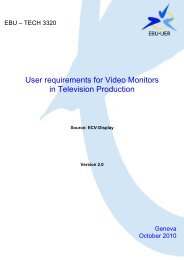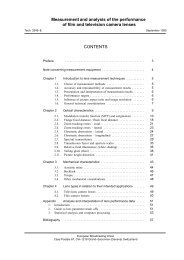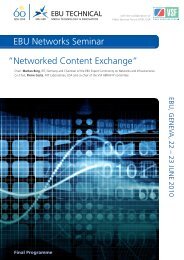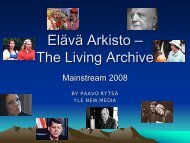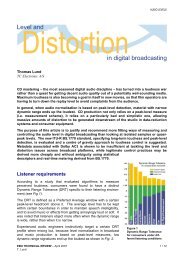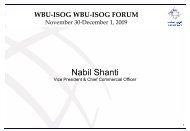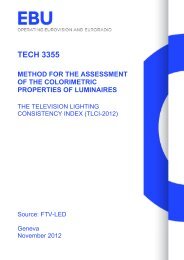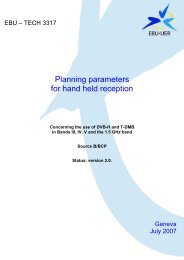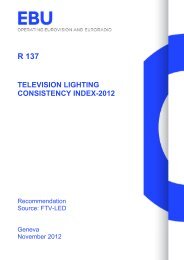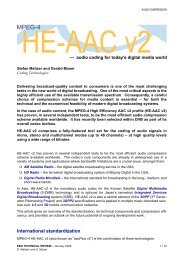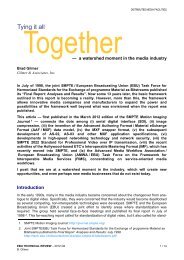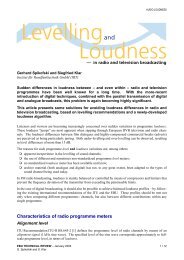Production Technology Seminar 2009 - EBU Technical
Production Technology Seminar 2009 - EBU Technical
Production Technology Seminar 2009 - EBU Technical
Create successful ePaper yourself
Turn your PDF publications into a flip-book with our unique Google optimized e-Paper software.
37<br />
servers managers, the more fingers in the pie!) - unless somehow complexity can be used to reduce risk<br />
- and to the reliability of individual devices. Besides the loss of storage devices there are many more<br />
risks: format obsolescence, IT infrastructure obsolescence, file corruption, system corruption, human<br />
errors and other human actions. They all increase in significance (impact) in proportion to the amount of<br />
storage in use.<br />
First conclusion: as storage gets really cheap… it gets really risky.<br />
The control of loss includes:<br />
� The prevention of loss. This is where most of the attention (and research) is directed: reducing<br />
MTBF for devices, making copies (!), using storage management layer(s), introducing virtual storage<br />
layer(s), using Digital Library technology (OAIS „packages‟ and preservation metadata).<br />
� The mitigation of loss. When it‟s gone, it‟s gone? [30]. But this doesn‟t have to be the case. For<br />
example, if you have a BMP raster scan image file, with 160 errors in 40k [31-right], the bit errors are<br />
completely local and only affect the byte they occur on. If you have a GIF compressed file with 3 errors<br />
in 10k [30-center], the bit errors affect the equations which re-create the image from an encoded form<br />
and that propagate the errors. That is another reason to have uncompressed files in the archives.<br />
Fortunately, there are files that can be read despite errors - anything with a sequence (lines, pages,<br />
images with raster scan (or any sequential ordering of the data), audio, video. The structure „unit of<br />
loss‟ needs then to be identifiable: particular pixels, samples, lines (text or video!), pages/frames. A<br />
structure of independent units is also contributing to the mitigation of loss: files with independent units<br />
(pages, lines, bytes) - so that the loss of one element does not affect any others. Unfortunately, most<br />
files have lost this property because compression removed redundancy - using the similarities between<br />
units ties them together - and whole conglomerations of data are affected by a single byte error.<br />
In summary, a survival strategy:<br />
� Understand costs and risks. But is very difficult to get from the storage industry substantial information<br />
(besides the MTBF of their hardware devices); e.g. how much it will cost to have a 1% error rate versus<br />
a 0.1 error rate.<br />
� Keep (uncompressed) master material off-line (for now).<br />
� Use only expensive managed on-line servers where usage (production/public access) justifies the<br />
cost.<br />
� The cost-benefits equation of robots needs re-analysis against very cheap hard drives, for low-volume<br />
access.<br />
� Uncompressed files have lowest risk.<br />
� Migrate every five years.<br />
… If delegating storage: maintain control!<br />
2.10 Living in a Digital World - PrestoSpace & PrestoPRIME<br />
Daniel Teruggi, INA Recherche, France<br />
1) Getting your old analogue assets into the Digital World<br />
The European PrestoSpace 25 project (2004 - 2008) involved 35 Partners collaborating in the project,<br />
180 Archives users in 52 countries, 144 service providers in 26 countries.<br />
The project [4] was about from making new machines for audio, video, and film handling, acquisition and<br />
digitisation [5], restoration [6], storage and archive management, metadata extraction [7] to a Turnkey<br />
System for hosting Digital Audiovisual Archives. The main objective was to make preservation faster,<br />
better, and cheaper! A main concept was the Preservation Factory 26 , to take the industrial model versus<br />
the mainly applied artisanal approach.<br />
25 http://prestospace.org/<br />
26 This concept had not been protected and was „taken over‟ and trademarked by Sony! Since the new name of „PrestoSpace<br />
Factory‟<br />
© <strong>EBU</strong> <strong>2009</strong> / <strong>Production</strong> <strong>Technology</strong> seminar / January 27 - 29, <strong>2009</strong><br />
Reproduction prohibited without written permission of <strong>EBU</strong> TECHNICAL & <strong>EBU</strong> TRAINING



